Battle for Figs: Victory
Some History
I don’t know the score over the years, but this year’s victory is mine. The battles have been with scale insects, both armored scales and their cousins, mealybugs (but rarely both in the same year), on my greenhouse fig plants.
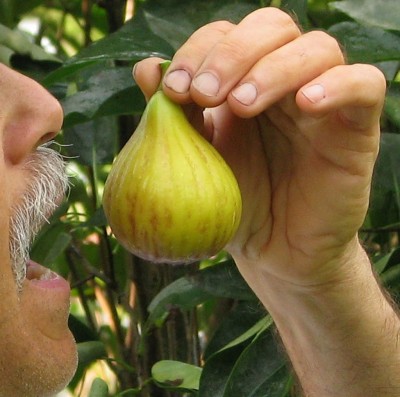
Those fig plants are planted in the ground in a minimally heated greenhouse, where winter temperatures can sink to about 35°F. The oldest of these plants have trunks 8 inches in diameter. They thrived for years without any pest problems, scale of otherwise. A few years ago, the insects made their appearance, sometimes ruining almost the whole crop.
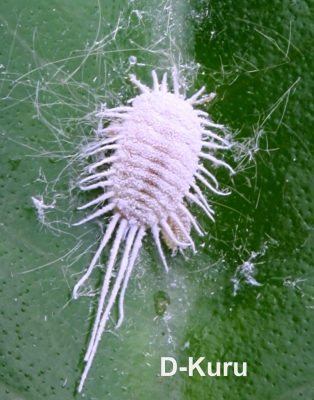
Over the years I fought them in various ways. One year it was spraying the dormant plants with alcohol. Another year it was, more aggressively, scrubbing trunks and stems of dormant plants with a toothbrush dipped in alcohol. Ants herd and protect scale insects, so another year I fenced the ants off the plants with a band of masking tape coated with forever (almost) sticky Tangletrap around the trunk of each plant.
An expensive but short-lived success was the two releases of the predatory ladybird beetle Cryptolaemus montrouzieri and the parasitoid wasp Anagyrus pseudococci.
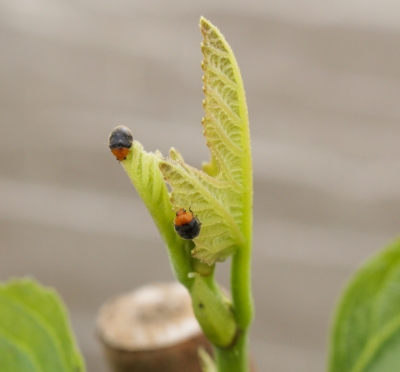
Mealybug destroyer
These biocontrol helpers ended up valuing each fig at about a dollar, still worth it. I screened all openings in the greenhouse, hoping to perennialize them inside. (It was not effective.)
Battle Plan, Done
So this year I tried a multipronged approach.
The biggest change was, rather than growing the figs as bushy trees, training them as espaliers. Espalier is the training of plants to an orderly, usually two-dimensional form both for beauty and, in the case of fruit plants, for good production of high quality fruit. For my figs, an additional benefit would be that each plant would only have one point of contact — its trunk — with the ground. IA band of masking tape coated with Tangletrap would be a roadblock on the ant highway. (Plus the look of the plants always elicits a “Wow” from visitors.)
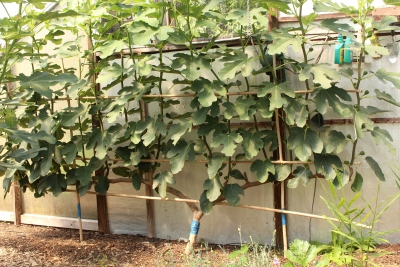
The fig plant growing near the greenhouse endwall has a short trunk that, after rising to about 18 inches from ground level, bifurcates into two, self-supporting horizontal arms extending parallel to the wall in opposite directions. At the head of each of the south beds, a fig tree is planted each of whose trunk is terminated by just a single, self-supporting, horizontal arm reaching down the bed to the sidewall. With just a trunk and one or two arms, thoroughly scrubbing down the dormant plant with alcohol is a relatively quick job. Quick enough to prevent 2 or 3 scrubbing before plants resume growth in early spring from becoming tedious.

Another nice feature of this training system is that pruning the plants at the end of the season is a no-brainer. Vertical shoots that rise up from the horizontal arms are thinned to keep neighboring shoots 8 inches apart and helped along in their vertical growth by being trained to pieces of bamboo attached to the greenhouse roof. (Yes, an ant could walk up the wall and across the roof of the greenhouse and then down the bamboo to get at the plants but they are either not that smart or energetic; it hasn’t happened.)
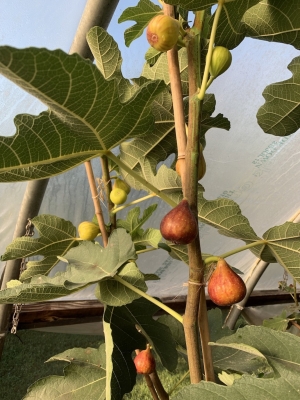
A little later in the early part of the greenhouse growing season I gave the plants some dowsings with neem oil. I’m not sure how effective the neem component is but “horticultural oil” itself is effective in fighting off scale insects.
A ring of cinnamon around the base of each plant provided further disincentive to the ants, who will not cross a cinnamon line. The cinnamon and the Tangletrap did need renewal once per season.
As new fig shoots soared skyward near the greenhouse roof, I used a pole pruner to prune out the top of the growing shoot. Side branches, of course, then grew, and I periodically had to to hack them back also.
Uh Oh, But All Still Good
Everything was copacetic and we were harvesting figs, which formed along the vertical stems at the juncture of almost every leaf. Then, in late August I noticed some mealybugs on one plant. Time for Cryptolaemus montrouzieri again. I released them in early September and we were back in business, harvesting large handfuls of three different varieties of delciously sweet figs — San Piero, Brown Turkey, and Rabbi Samuel — daily.
And then, just today, I noticed armored scales on the plants, and a few ants! I’m not sure how the ants are getting onto the plants, but one possible “benefit” of the armored scales is hardly any mealybugs. Perhaps they can’t coexist.

All the measures I took against mealybugs should also be effective against the armored scales, except for the Cryptolaemus montrouzieri. Their predator Aphytis melinus, also known as the Golden Chalcid, has been effective against armored scales.
I’m not taking action. With less sunlight and cooler temperatures the figs trees have slowed down, running out of new stems on which to hang fruit. No matter; it’s been a good season of fresh figs.

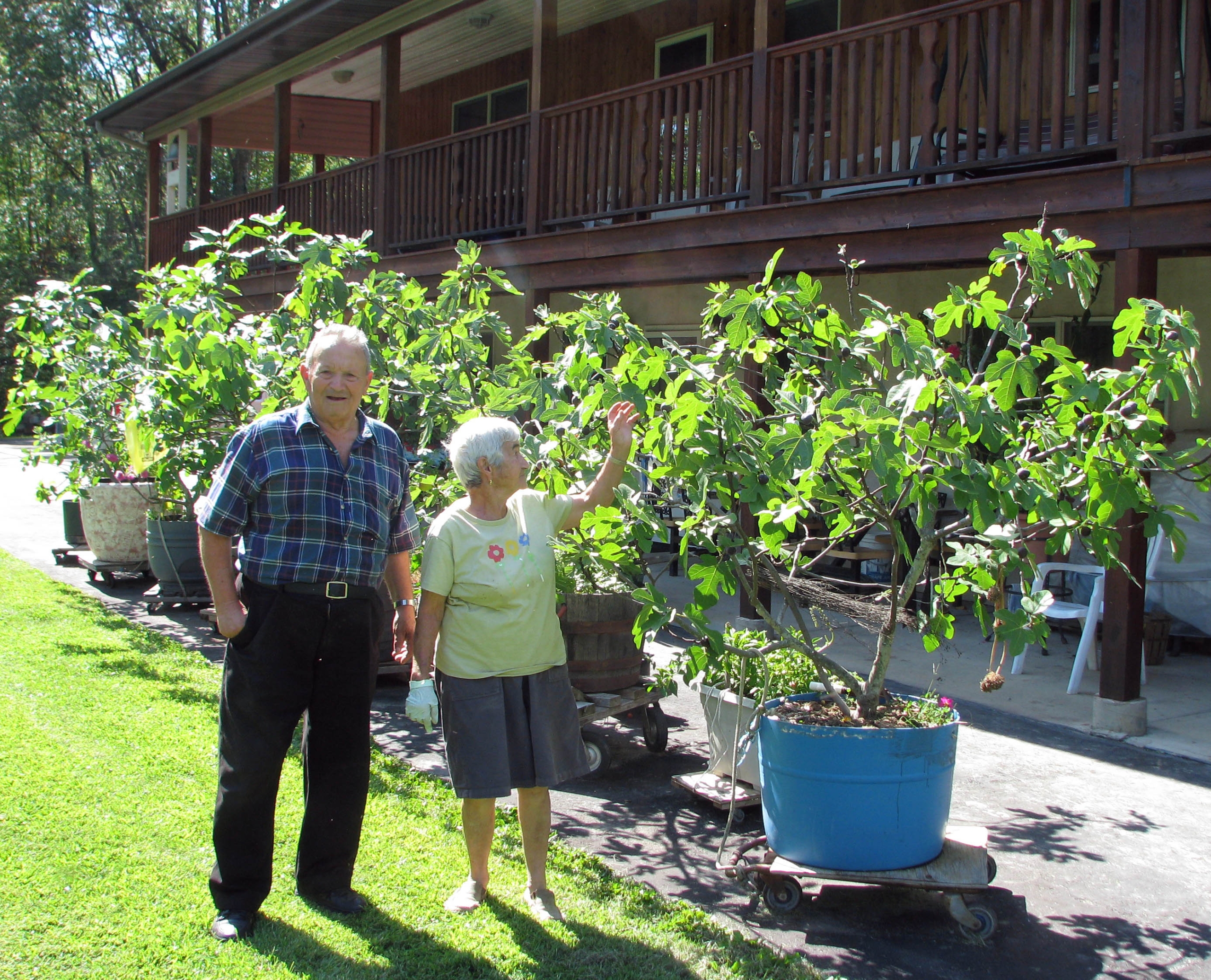
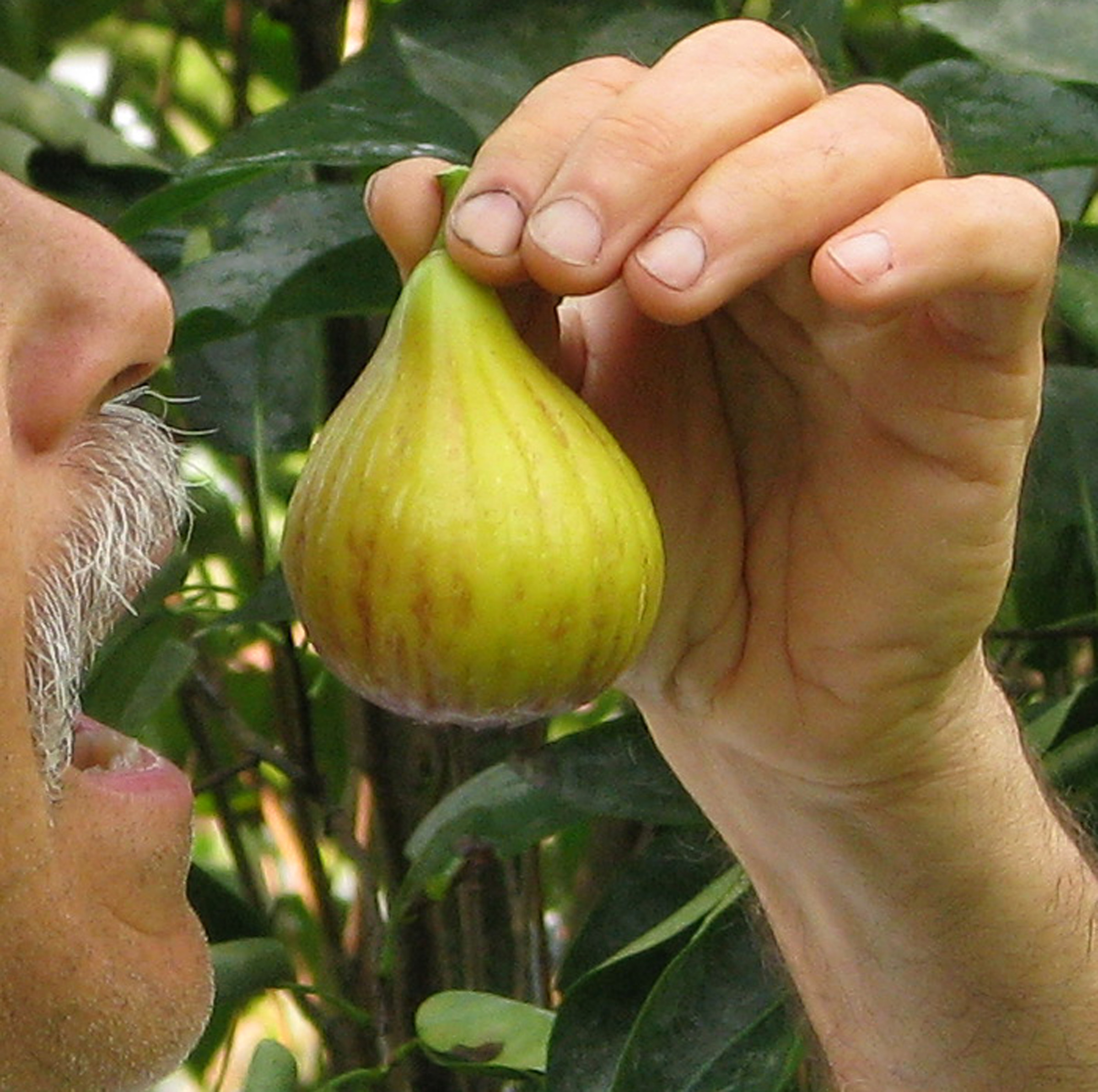

I have picked figs in many places in Midlands of South Carolina & never saw the scale you are speaking of.
Now the Camilla & azalea are covered with scale, but not the figs.
I have a friend who has a family home stead, with a fig tree with every thing going wrong. Weeds & vines growing on it, lots of dead wood, weak branches & many sucker.
I helped him clean it up & it was full of figs this year, but no scale.
Is it to hot here?
We do have nematodes, that will hurt a tree, but Organic Compost helps keep them away & there is a nematode that eats other nematodes, that can help.
Love your blog, which I found by googling figs a few years back, when your first blog about the figs.
My outdoor figs, growing in pots so I can move them to protection for winter, never get scale either. A garden is a complex ecosystem. For some reason, the balance that keeps scale at bay outdoors has been upset in my greenhouse. Either next year or the year after it will be timeto replace the greenhouse cover. I’ll leave it off for the growing season and see what happens. (Possibly no scale but plenty of yellow jackets moving it feast on the figs.)
Help! When my mother passed in 2014, we took her fig plant which had successfully produced fruit for years and transplanted to a larger pot with fresh soil. The roots were growing out of bottom and there were cracks in sides of pot. Five years later and not one fig. The fig plant (now 4 feet tall and wide) comes indoors every fall as we live in New England. There’s been new growth but no fruit! Any suggestions?
What were the growing conditions at your mother’s? Sunlight? Summer warmth? Where did she live?
Growing conditions: in a smaller pot (plant was extremely overgrown and roots growing out bottom). Sunny location. Came out of garage and stayed outdoors for approximately 6 months. She never fertilized it. She lived in downstate NY. About 5 degrees warmer than me in Massachusetts. I on the other hand have given it fresh soil, fertilized and plenty of sunshine. Comes indoors at first frost! But no fruit!
How long have you had the plant? What about pruning?
I’ve had the plant since 2014. Have never pruned. Wouldn’t even know where to begin !
I would cut some of the branches down to about 18″. It may be a fig that only fruits on new growth. Cutting it back (but not too far) will stimulate new, fruit-bearing wood next season.
My small greenhouse is quite empty in summer…too hot for most things, but perfect for Portulacas. The portulacas attract the mealy bugs which had been attacking my cacti and succulents for years. At the end of the season the portulacas go in the compost and I have been totally free of mealies for several years now. Congratulations on your hard-won fig crop!
I will try that although, as always, I’m skeptical.
Interesting to read about the insect challenge. I was planning to rebuild my garden to better insulate from ‘animals’ and wasn’t thinking of the bugs. Frustrating working and nurturing these plants and trees only to be humbled by these various predators.
Thanks for your inspiring stories.
Harry
Look upon it as these creatures add interest to gardening.
Thanks for the wonderful intervention tips.
I have 2 figs (Neri) which I have outside on my very sunny deck all summer and overwinter through dormant cycle in my basement. I have lots of baby figs, but very few ripen. Any ideas?
Not enough sun, not enough heat, incorrect pruning, or your summer climate is too short for that variety.
Great post! I have been trying for few years now to successfully grow figs in Maine. I have a greenhouse, but it is unheated and too cold for the depths of winter so
I bring the plant indoors. I could just let it die back each season but as you well know, the plant doesn’t have enough time to set fruit and ripen it.
I have small brown ants colonizing my raised beds in the greenhouse. I occasionally
unearth them and they get agitated and scatter, carrying eggs and I end up with bites on my hand or ankles. Greenhouse “floor” is gravel. Is there a way cinnamon will force them out? I thought of trying boiling water when I am not growing veg.
The bed is made of 2 inch thick lumber that is about 2 ft. high. No bottom. It sits on the gravel inside the greenhouse.
Hate to say it but I doubt anything except harsh chemicals will get rid of the ants. Do they damage anything though? A lot of other creatures naturally eat ants.
You are certainly working hard to enjoy those figs – – – absolutely worth it I am sure!
True. True. Plus it’s fun and interesting.
Hey Lee,
This year, I planted a Brown Turkey, recommended for here in N. AUSTIN (Tx). This summer, I met someone not too far away from me who had a HUGE crop of VERY delicious Texas Everbearing Figs, which were plentiful, juicy, had zero pest or disease problems, and was fantastic in every way. About 60 ft away, she also has a Brown Turkey Fig tree, which had HUGE figs, but which were bone dry, and every fruit was badly scarred by insect damage. They were not appetizing in any way! Based on this experience, honestly, I’m wondering if I should just dig out the Brown Turkey and start over with a Texas Everbearing. Should I expect repeats of this kind of situation in the future? Or does this kind of thing cycle back & forth, with maybe next year being vastly better for the Brown Turkey tree???
~Ed in Austin, TX.
Thanks for sharing!
Other things could be responsible besides variety? I would keep the Brown Turkey and see what happens. My guess is that it will be fine. Let me know, if you remember to.
Do you make fig jam?
No. I’m good at growing fruits. Bad with cooking them. Plus, I find a well-grown fruit so delectable that it would seem to do it a disservice to do anything with it except take a bite. (Not always, though. It’s just that I’ve never made anything very good with fruits.)
Some years ago I was gifted a potted Meyer lemon with the same issues and the problem was the soil it was planted in. I’m wondering if your greenhouse topsoil is the culprit. Maybe a soil purge with a blow torch (replicate a natural fire) will destroy eggs laid at the surface that hatch out later. The remaining char will continue to benefit the soil.
I believe scale insects overwinter on plant parts, not in the soil. So torching the soil wouldn’t work. It would be hard to be thorough with the soil, just as it’s hard to thoroughly scrub them off the plants in late winter. Also torching the soil in the greenhouse would be too threatening to the greenhouse covering and any existing plants.
Every year my figs never finish growing in NJ. I even have a greenhouse that I put over them that I cover up in Oct to try and extend them but no such luck. Does the greenhouse cover need to be clear? Right now on the 22nd of Oct I have about 3-50 figs that are about 2-3 weeks away if it was summer weather here. The figs are mission and brown turkey. I just bought this summer Chicago and Tennessee figs. Any suggestions would be greatly appreciated…
The figs need light and heat to ripen. Eventually, this far north, they have neither, and peter out.
Just wondering what changed. I have had these plants for 15+ years and always had figs from them, Not a lot but a good amount. The last 3-4 years I have only gotten maybe 1/2 dozen off them. They are as healthy as could be. They grow like crazy. I cut them back a lot. Any ideas? Also do they need a clear cover for the greenhouse to get them enough light.
Thank you
Yes, they need a clear cover. Think of what has changed over the years: increasing shade?Root congestion? Worn out soil?
Do you find this candelabra shape to be the most prolific for fruiting? I just got my Chicago Hardy to plant against my south-facing face in a protected corner, and I’m planning to espalier train it for more warmth and protection. I also want to actually get the most fruit possible. Thanks.
I find that’s it’s very prolific and, just as important, very manageable and easy to prune. If you do this outdoors, it has to be somewhere where you know that the trunk and arms will not be killed by winter cold. I do it in my greenhouse, which never drops below 35 degrees F.
Do you know what the ID is of the armored scale in your photo above?
No,, I don’t